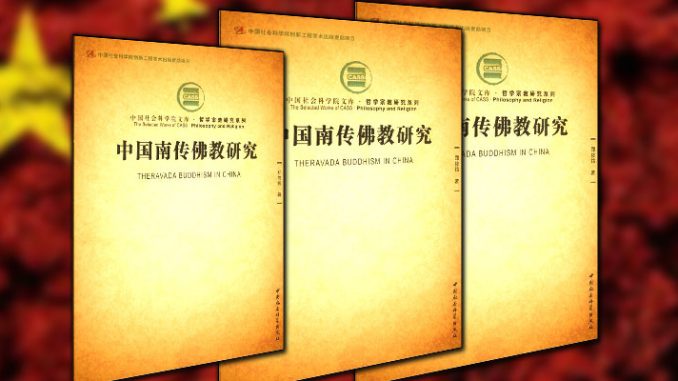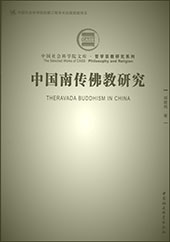
Title: 中国南传佛教研究 (Theravāda Buddhism in China)
Author: 郑篠筠 (Xiaoyun Zheng)
Beijing: China Social Sciences Press (2012)
The book features four thematic sections. Section One (Chapters 1-2) systematically explains the evolutions of Theravāda Buddhism in China, and points out the three characteristics of its dissemination. Firstly, cross-border ethnic cultural diffusion played an essential role in the dissemination of Theravāda Buddhism in China. Secondly, Theravāda Buddhism in China not only has a close relationship with regimes, but also depends on certain political groups. And finally, Theravāda Buddhism in China laid the groundwork for the establishment of unique institutions for lay Buddhists (p.64-65).
In the next section (Chapters 3-4), Zheng analyzes the classic teachings and main branches of Theravāda Buddhism in China. In this section, Zheng compares the differences and similarities among the branches and also especially, with branches in Thailand, Myanmar, Sri Lanka and Yunnan Province in China, which have remained relatively understudied by Chinese academia. With this comparison, the section highlights the cultural origin of Theravāda Buddhism in China and its deep influences by Buddhism in Southeast Asia.
 Section Three (Chapters 5-8) explores the administrative system of Theravāda Buddhism in China, which is seldom scrutinized by academia both in China and abroad. This is one of the major points that stands out in this book. Zheng explores the unique features of Theravāda Buddhism in China, such as its religion-politics relationship and administrative system. Moreover, Zheng originally demonstrates the administrative system of lay Buddhists and its operating patterns, that is, that selected lay Buddhists take charge of economic affairs and economic relationships between temples and the secular society, and organize believers to take part in all kinds of Buddhist events. At the same time, these lay Buddhists do not intervene in the internal affairs of monkhood and enjoy no religious privileges. As Zheng concludes, Theravāda Buddhism in China benefits a lot from its administrative system of lay Buddhists, which makes use of the elites among believers to manage both social and economic affairs of Buddhist civil society, while effectively integrating limited religious and social resources (p.190). This explanation is helpful to comprehend the dynamics of Buddhist civil society in Thailand and Myanmar, which share many similarities with that of Theravāda Buddhism in China.
Section Three (Chapters 5-8) explores the administrative system of Theravāda Buddhism in China, which is seldom scrutinized by academia both in China and abroad. This is one of the major points that stands out in this book. Zheng explores the unique features of Theravāda Buddhism in China, such as its religion-politics relationship and administrative system. Moreover, Zheng originally demonstrates the administrative system of lay Buddhists and its operating patterns, that is, that selected lay Buddhists take charge of economic affairs and economic relationships between temples and the secular society, and organize believers to take part in all kinds of Buddhist events. At the same time, these lay Buddhists do not intervene in the internal affairs of monkhood and enjoy no religious privileges. As Zheng concludes, Theravāda Buddhism in China benefits a lot from its administrative system of lay Buddhists, which makes use of the elites among believers to manage both social and economic affairs of Buddhist civil society, while effectively integrating limited religious and social resources (p.190). This explanation is helpful to comprehend the dynamics of Buddhist civil society in Thailand and Myanmar, which share many similarities with that of Theravāda Buddhism in China.
In Section Four (Chapters 9-12), Zheng analyzes the adaptability and evolution of Theravāda Buddhism in China especially when it is practiced as part of a process of social participation, such as in monastic education, monastic offerings, Buddhist Ceremonies, and charity. By addressing the charity of Theravāda Buddhism, Zheng argues that public welfare is the most effective approach for Buddhism’s participation in public affairs and in the promotion of peaceful relationship between China and Southeast Asian countries. Zheng describes one Buddhist NGO, “Home of Buddha’s Light,” whose work includes of integrating all the resources of Buddhist civil society, taking care of the HIV/AIDS victims on the China-Myanmar border, and providing special contributions to society. Zheng also notes, however, that the NGO has its own limitations, especially on the issues of insufficient supervisory mechanism and lack of personnel. In my personal view, despite its limitations, it might be the second-best solution to establish a public-private partnership among Buddhist NGOs, Buddhism civil society and governmental authorities.
While exploring many issues in the literature of Theravāda Buddhism in China, the book raises several noteworthy questions. For example, did Theravāda Buddhism in China ever play an active role in establishing friendly relations between China and Southeast Asian countries? In regards to the unique administrative system of lay Buddhists of Theravāda Buddhism as found in China, should its drawn lessons be applied to Buddhist civil societies in Southeast Asian countries (e.g., Thailand and Myanmar)? Would Chinese Buddhist elites believe that their religious practices can function as a form of soft-diplomacy between China and Southeast Asian countries?Is there any Buddhist NGO similar to “Home of Buddha’s Light” in Southeast Asian countries? If yes, what are the difference and similarities between them? Although the answers to these questions need research in further, I believe it is important to enrich our understanding on the religious praxis of Theravāda Buddhism.
In summary, within Chinese literature on this subject, this book is an invaluable reading on Theravāda Buddhism. It does raise awareness of the unique value and function of Theravāda Buddhism in China. In addition, it also offers important hints on how to read the literature of Buddhism in Southeast Asia. All scholars, students and organizations that are interested in Theravāda Buddhism (especially Theravāda Buddhism in China) would benefit from this book, one that also deserves to be a valuable addition to academic and university libraries.
陈锴 (Kai Chen)
Post-doctoral Research Fellow, Zhejiang University, China
Visiting Scholar, East Asian Institute, National University of Singapore
Kyoto Review of Southeast Asia. Issue 15 (March 2014). The South China Sea
